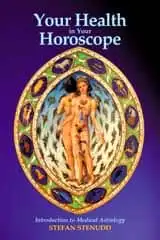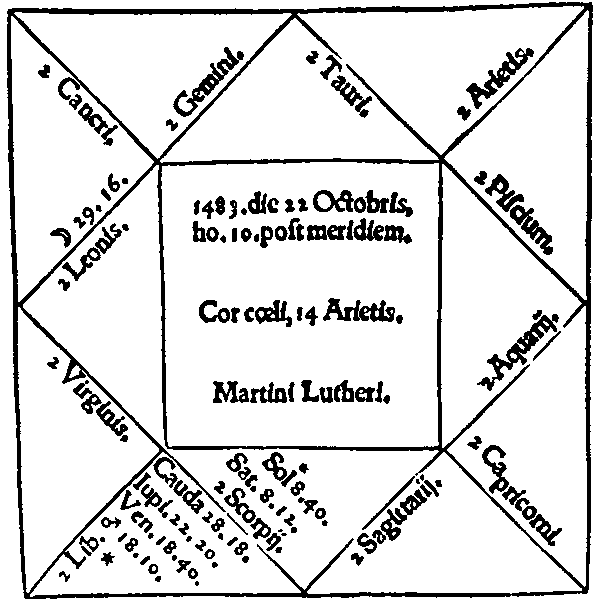|
by Stefan Stenudd
|
The Houses in the Complete HoroscopeLife Environments in Classical Astrology
Here are the twelve Houses with keywords for what part of life they describe:
ZodiacThe Houses are sort of mirrors of the twelve Zodiac signs, so that the part of life each House concerns is deducted from the quality of its corresponding Zodiac sign:
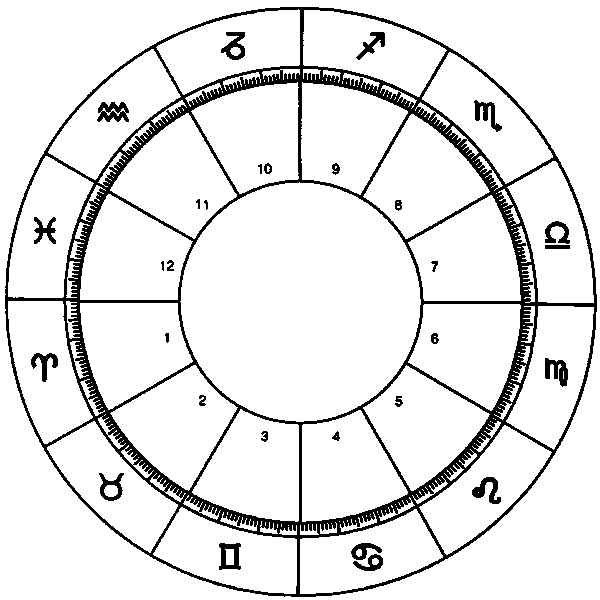 Blank horoscope chart with Zodiac signs and corresponding Houses.
In the complete horoscope chart, the House system spins around the Zodiac counter-clockwise. What decides the House positions is the Ascendant, the Rising point in the east. That's the cusp of the 1st House. The Ascendant travels a full 360° through the Zodiac each day, so it can be in any position in the Zodiac. The rest of the Houses follow in strict order.
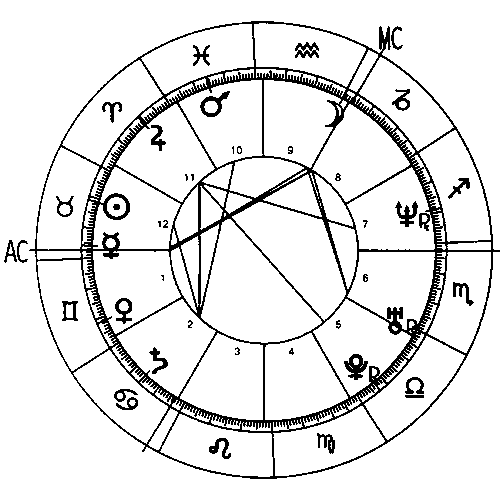
House systemsThere are several ways of calculating the House positions. The most established ones in western astrology are Placidus and Equal House.In the former, Houses have differing sizes, and Medium Coeli (MC) is at the cusp of the 10th House. Also, the Descendant starts the 7th House, and the IC starts the 4th House. In the latter, all Houses are of the same 30° size, as its name suggests. The MC can be anywhere from House 7 to 12, but the Descendant is always at the cusp of the 7th House. I prefer the Equal House system, for several reasons. For example, it matches the sizes of the Zodiac signs, which are equal, and it is the oldest system, supported already by Ptolemy. Furthermore, it keeps the aspecting relations between the Houses intact — a relation that helps a lot in understanding the Houses and interpreting them in the chart.
Martin Luther's horoscope chart, made in the envelope fashion that was the standard in the renaissance. Each triangle represents a House, with the cusp of the 1st House (the Ascendant) to the left, marked as 2° Virgo. The Equal House system is used.
AspectsAspects are certain angles between planets or other points in the horoscope chart. The major ones are the conjunction (0°), the opposition (180°), the trine (120°), the square (90°), and the sextile (60°). Also the Houses show relations that are expressions of aspects.
Oppositions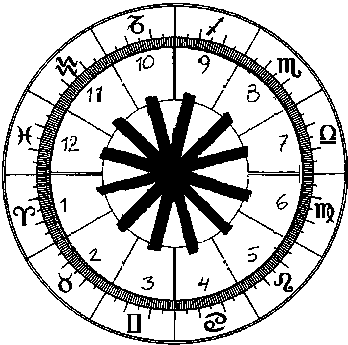 A good example of the aspect relations between the Houses is the opposition, 180° apart. This aspect points out irreconcilable differences, opposing interests or perspectives that usually relate only as "either or".
A good example of the aspect relations between the Houses is the opposition, 180° apart. This aspect points out irreconcilable differences, opposing interests or perspectives that usually relate only as "either or".These are the oppositions of the Houses:
2nd House — 8th House 3rd House — 9th House 4th House — 10th House 5th House — 11th House 6th House — 12th House
The opposition is present also in non-Equal House systems, since opposing Houses are the same size also there, but that is not necessarily the case with other aspects.
Trines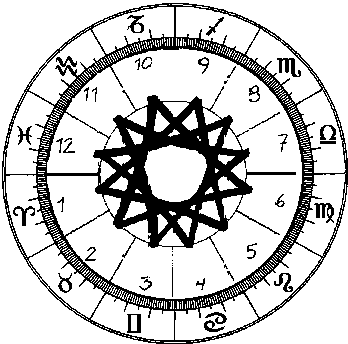 The trine points out harmonious relations, things that work in accordance with each other. Here are the trines (120°), which correspond to Zodiac signs being of the same element:
The trine points out harmonious relations, things that work in accordance with each other. Here are the trines (120°), which correspond to Zodiac signs being of the same element:
2nd House — 6th House — 10th House (earth) 3rd House — 7th House — 11th House (air) 4th House — 8th House — 12th House (water)
Squares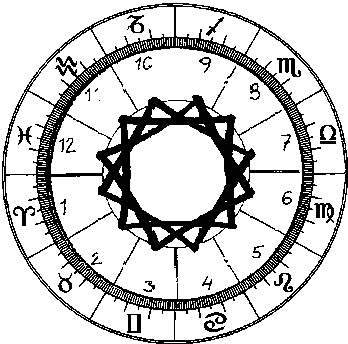 The square (90°) points out conflicts, things that work against each other — either in a productive or a destructive way. In the Zodiac, signs at square distance have the same quality — cardinal, fixed or mutable.
The square (90°) points out conflicts, things that work against each other — either in a productive or a destructive way. In the Zodiac, signs at square distance have the same quality — cardinal, fixed or mutable.Here are the House squares:
2nd House — 5th House — 8th House — 11th House (fixed) 3rd House — 6th House — 9th House — 12th House (mutable)
Sextiles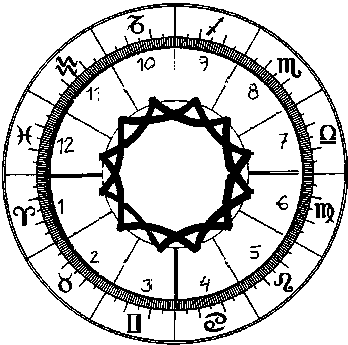 Finally, the sextile (60°) describes cooperation, things that work well together. In the Zodiac this corresponds to signs that are said to have either a positive or a negative charge. Fire and air signs are regarded as positive, while earth and water signs are negative. Thus, in the Zodiac circle, every other sign is positive and every other negative.
Finally, the sextile (60°) describes cooperation, things that work well together. In the Zodiac this corresponds to signs that are said to have either a positive or a negative charge. Fire and air signs are regarded as positive, while earth and water signs are negative. Thus, in the Zodiac circle, every other sign is positive and every other negative.Here are the House sextiles:
2nd House — 4th House — 6th House — 8th House — 10th House — 12th House (negative)
EnvironmentSo, much of the significance of each House can be told by the characters described above, shown by the aspects and the Zodiac signs they correspond to.Still, it must be remembered that the Houses do not equal the Zodiac signs. They just carry their characters in what environment, what part of life, they relate to. Here it is combined for each House:
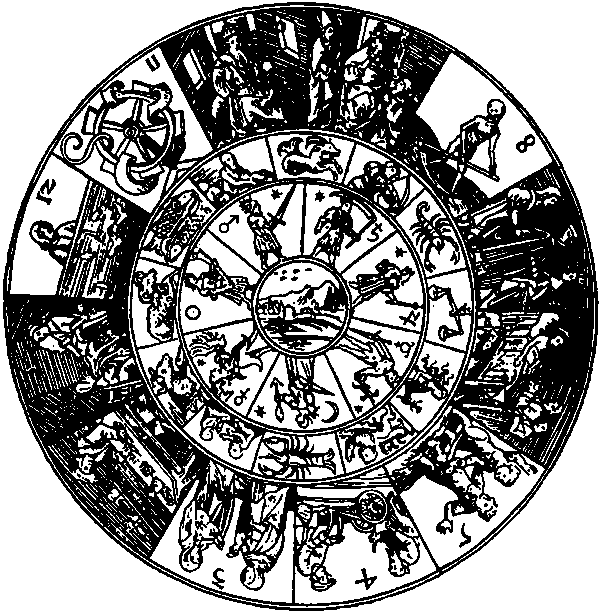 The astrological houses. Woodcut after Georg Peurbach, 1515.
House positionsRemember that in the complete horoscope chart, the Houses can be in any other signs than those they have gotten much of their characters from. The 1st House can be in Aries, but also in any other sign of the Zodiac. The rest of the Houses follow in strict order, so a certain position of the Ascendant leads to the Houses arranging themselves accordingly.One could say that if the Houses are indeed in their "natural" signs — 1st in Aries and so on — it would be the most agreeable position, but that is not necessarily so. When House and Zodiac sign match that well, it can tend to dim the dynamics of the chart, so that things get a bit too predictable, too typical, with little room for originality and surprise. If the Houses are instead in signs of opposite charge — positive in negative, and the other way around — already this stimulates, gives ground for creativity. In opposing signs there is a chance to accomplish balance in one's life, in trine signs different aspects of life can run quite smoothly, whereas in square signs it can either be very constructive or a mess... It is the unique mix of the ingredients in a chart that shows personality, and what makes life an intriguing challenge.
Split signOf course, it also often happens that Houses are split between two signs — rarely are the cusps of the Houses exactly at the cusps of the Zodiac signs. This must be taken into account in the interpretation of the horoscope.There are two major considerations to be done — that of time and that of dominance. Time works so that the environment of a House will at first have the character of the first sign, and later on of the next sign. Their extension in time will be comparable to the share the signs have of the House. For example, if the 6th House is one third Pisces and then two thirds Aries, then that person's work will first be a bit confused, searching for a way to do it right, and then active, intense, maybe rushing it. Each new work the person gets will follow this pattern, and in the same proportions — one third of the employment according to the first sign, the rest according to the following sign. Dominance is something less precise. If most of a House is in one sign, that sign character will have a tendency to dominate, through all time. Even more so, if one or more planets in that House are in one sign and not the other. The positions of the planets are the most important, when interpreting how things will be in the environment that House describes.
Empty HousesHouses with no planets in them signal fields of life where not that much happens, at least not very significant things. Those environments are not the most important ones in that person's life.
The HousesHere are the twelve Houses of the horoscope, with links to the webpage of each:
MenuCOMPLETE HOROSCOPEHow to Make Your Own HoroscopeYour Health HoroscopeSex in Your HoroscopeZodiac ArchetypesFinancial AstrologyDaily Horoscope Guide — What to ExpectTetrabiblos — the Ancient Astrology BibleHOROSCOPE BASICSZodiac — the "how" of the horoscopePlanets — the "what" of the horoscopeHouses — the "where" of the horoscopeAspects — the "why" of the horoscopeFAMOUS HOROSCOPESDonald Trump — 2025 inauguration horoscope2024 presidential election horoscope for Kamala Harris2024 presidential election horoscopes for Donald Trump and Joe BidenJoe Biden's 2020 presidential election horoscopePete Buttigieg's 2020 presidential election horoscopeDonald Trump — impeachment horoscopeDonald Trump — will he resign?Hillary ClintonMike PenceBarack ObamaAnders Behring BreivikMichael JacksonSarah PalinBrad PittThe USA Horoscope — Finding and Reading ItPREDICTIONSThe USA Pluto return 2022 horoscopeCapitol attack horoscopeCovid-19 coronavirus horoscopeFuture of the InternetThe Age of AquariusUSA 2016 ElectionMundane Pluto — Its Effect on SocietyMundane Neptune — Its Effect on the ArtsMISCAbout the Complete Horoscope WebsiteDisappearing Ascendant — Latitude EffectsThe Envelope Chart — Horoscope of the PastAstrology LinksAstrologi på svenskaContactCookiesZODIAC SIGNSThe twelve Zodiac signs and what they mean in astrology.
MY OTHER WEBSITES
Tarot Card Meanings
I Ching Online
Stefan Stenudd
About meI'm a Swedish astrologer, author and historian of ideas, researching ancient thought and mythology. My personal website: stenudd.com
|
|||||||||||||||
